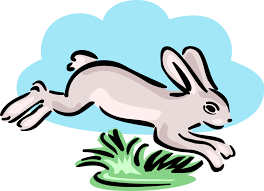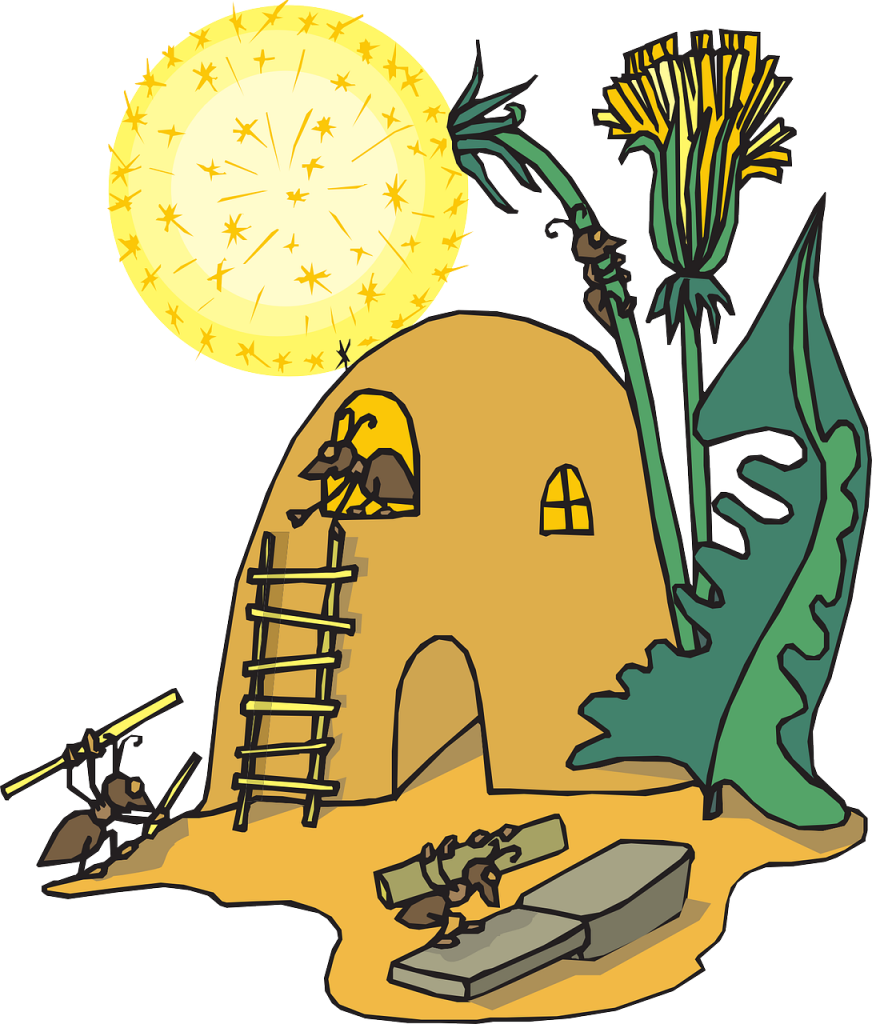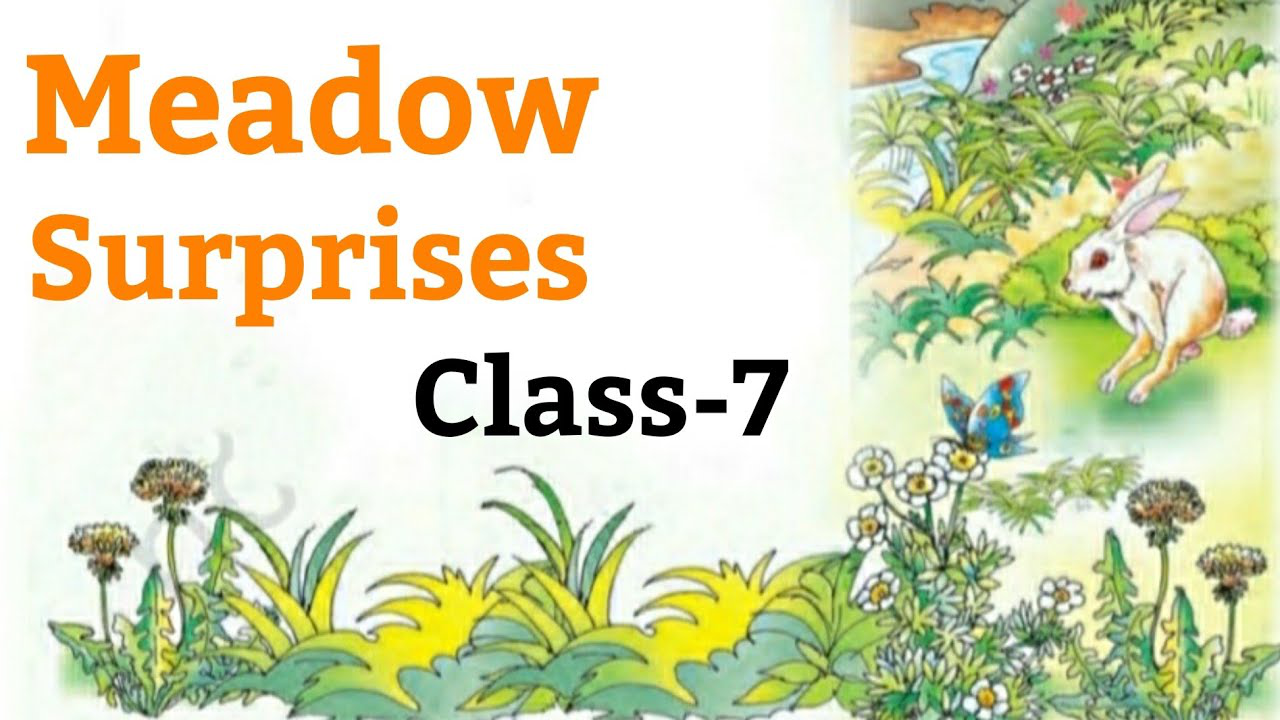MEADOW SURPRISES for Class 7 ENGLISH
THEME
The poet details the different surprises that one can see in a meadow – we just need a curious eye and keep our ears open.
THEME
The poet details the different surprises that one can see in a meadow – we just need a curious eye and keep our ears open.
EXPLANATION
Kavi vibhinn surprises ki details dete hai jinhe ghaas ke maidan main dekha ja sakta hai- hume bas ek curious aankh aur apne kaan khule rakhne ki zaroorat hai.
EXPLANATION
कवि विभिन्न आश्चर्यों का विवरण देते हैं जिन्हें घास के मैदान में देखा जा सकता है - हमें बस एक जिज्ञासु आँख और अपने कान खुले रखने की जरूरत है।
ABOUT THE AUTHOR

Lois Brandt Phillips was born on April 22, 1829, was a wealthy landowner and rancher in Los Angeles County, California.
ABOUT THE AUTHOR

Lois Brandt Phillips was born on April 22, 1829, was a wealthy landowner and rancher in Los Angeles County, California.
EXPLANATION
Lois Brandt Phillips ka janam April 22, 1829 ko hua tha, veh Los Angeles County, California main ek dhani landowner aur rancher the.
EXPLANATION
Lois Brandt Phillips का जन्म 22 अप्रैल, 1829 को हुआ था, वह लॉस एंजिल्स काउंटी, कैलिफोर्निया में एक धनी ज़मींदार और रैंचर थे।
STANZA 1

Meadows have surprises,
You can find them if you look;
Walk softly through the velvet grass,
And listen by the brook.
STANZA 1

Meadows have surprises,
You can find them if you look;
Walk softly through the velvet grass,
And listen by the brook.
IMPORTANT WORDS
Meadows: grassland, घास का मैदान
Velvet: a fabric which has a soft feel, मख़मल
Brook: a small stream, छोटी जलधारा
IMPORTANT WORDS
Meadows: grassland, घास का मैदान
Velvet: a fabric which has a soft feel, मख़मल
Brook: a small stream, छोटी जलधारा
EXPLANATION
Kavi kehte hai ki ghaas ke maidano main kayi surprises hote hain. Agar koi dhyan se dekhe, toh unhe dhund sakta hai. Use keval naram (soft) ghaas par halke se chalne aur dhara main behte paani dwara utpan dhwani (sound) ko sunne ki zaroorat hai.
EXPLANATION
कवि कहते हैं कि घास के मैदान में ऐसी बहुत सी चीज़ें होती हैं जो हमें हैरान कर देती हैं। अगर कोई ध्यान से देखे, तो उन्हें ढूँढ सकता है। उसे केवल नरम घास पर हल्के से चलने और धारा में बहते पानी द्वारा उत्पन्न आवाज़ को सुनने की जरूरत है।
STANZA 2

You may see a butterfly
Rest upon a buttercup
And unfold its drinking straws
To sip the nectar up.
STANZA 2

You may see a butterfly
Rest upon a buttercup
And unfold its drinking straws
To sip the nectar up.
IMPORTANT WORDS
Buttercup: a type of flower, एक प्रकार का फूल
Drinking straws: the proboscis in the mouth of a butterfly which works as a straw, पीने की नली
IMPORTANT WORDS
Buttercup: a type of flower, एक प्रकार का फूल
Drinking straws: the proboscis in the mouth of a butterfly which works as a straw, पीने की नली
EXPLANATION
Jab ap ghaas ke maidan main chalte hain, to ap dekh sakte hain ki ek titli phool par bethi hai, phool ke meethe ras ko uski straw jaisi soond se choos rahi hai.
EXPLANATION
जब आप घास के मैदान में चलते हैं, तो आप देख सकते हैं कि एक तितली फूल पर बैठी है, फूल के मीठे रस को अपनी स्ट्रॉ जैसी सूंड से चूस रही है।
STANZA 3

You may scare a rabbit
Who is sitting very still;
Though at first you may not see him,
When he hops you will.
STANZA 3

You may scare a rabbit
Who is sitting very still;
Though at first you may not see him,
When he hops you will.
IMPORTANT WORDS
Still: not moving, स्थिर
Hops: to jump, उछलना
IMPORTANT WORDS
Still: not moving, स्थिर
Hops: to jump, उछलना
EXPLANATION
Aage kavi kehte hai ki ghaas main khargosh chipa hua ho sakta hai. Yeh abhi bhi baitha ho sakta hai lekin kisi insaan ke aane se dar sakta hai, aur bahar kood sakta hai. Koi khargosh ki upasthiti (presence) ko tabhi notice kar sakta hai jab koi use ghaas se bhar koodte hue dekhta hai.
EXPLANATION
आगे कवि कहते हैं कि घास में खरगोश छिपा हुआ हो सकता है। यह अभी भी बैठा हो सकता है लेकिन किसी इंसान के आने से डर सकता है, और बाहर कूद सकता है। कोई खरगोश की उपस्थिति को तभी नोटिस कर सकता है जब कोई उसे घास से बाहर कूदते हुए देखता है।
STANZA 4
A dandelion whose fuzzy head
Was golden days ago
Has turned to airy parachutes
That flutter when you blow.
Dandelion: a weed plant with flowers and leaves
STANZA 4
A dandelion whose fuzzy head
Was golden days ago
Has turned to airy parachutes
That flutter when you blow.
Dandelion: a weed plant with flowers and leaves
IMPORTANT WORDS
Fuzzy: having a frizzy texture, धुँधला
Flutter: to move or make something move quickly, लहराना
Parachutes: a device made of cloth used by skydivers to land safely, हवाई छतरी
IMPORTANT WORDS
Fuzzy: having a frizzy texture, धुँधला
Flutter: to move or make something move quickly, लहराना
Parachutes: a device made of cloth used by skydivers to land safely, हवाई छतरी
EXPLANATION
Kavi kehte hai ki koi murjhata dandelion phool dekh sakta hai. Yahan phool ke life cycle ke baare main bataya gaya hai. Ek baar jab phool golden yellow colour ke ho jate hai, to dheere-dheere petals apna rang kho bethti hain aur murjha jati hain. Ant main, ve girne lagti hain aur jab koi phool ko hawa uda kar le jati hai, to petals parachute ki tarah hawa main ud jati hain.
EXPLANATION
कवि कहते हैं कि कोई मुरझाता डंडेलिओं फूल देख सकता है। यहाँ फूल के जीवन चक्र के बारे में बताया गया है। एक बार जब फूल सुनहरे पीले रंग का हो जाता है, तो धीरे-धीरे पंखुड़ियाँ अपना रंग खो बैठती हैं और मुरझा जाती हैं। अंत में, वे गिरने लगती हैं और जब फूल को हवा उड़ा कर ले जाती है, तो पंखुड़ियाँ पैराशूट की तरह हवा में उड़ जाती हैं।
STANZA 5

Explore the meadow houses,
The burrows in the ground,
A nest beneath tall grasses,
The ant’s amazing mound.
STANZA 5

Explore the meadow houses,
The burrows in the ground,
A nest beneath tall grasses,
The ant’s amazing mound.
IMPORTANT WORDS
Explore: travel through in order to learn, भ्रमण करना
Meadow houses: farmhouses, घास के मैदान पर घर
Beneath: under, नीचे की ओर
Mound: ant hill, एक छोटी पहाड़ी
IMPORTANT WORDS
Explore: travel through in order to learn, भ्रमण करना
Meadow houses: farmhouses, घास के मैदान पर घर
Beneath: under, नीचे की ओर
Mound: ant hill, एक छोटी पहाड़ी
EXPLANATION
Jab koi ghaas ke maidan main jata hai, to vah farmhouse main ghoom sakta hai. Vibhin janwaro dwara khode ghaddo ko dekh sakta hai. Lambi ghaas ke neeche ghosle dekh sakta hai. Iske alawa, choti chittion dwara banaye ghar ko dekhna bhi nahin bhoolna chahiye.
EXPLANATION
जब कोई घास के मैदान में जाता है, तो वह फार्महाउस में घूम सकता है। विभिन्न जानवरों द्वारा खोदे गए गड्ढों को देख सकता है। लंबी घास के नीचे घोंसले देख सकता है। इसके अलावा, छोटी चींटियों द्वारा बनाए गए विशाल घर देखना नहीं भूलना चाहिए।
STANZA 6
Oh! Meadows have surprises
And many things to tell;
You may discover these yourself,
If you look and listen well.
STANZA 6

Oh! Meadows have surprises
And many things to tell;
You may discover these yourself,
If you look and listen well.
IMPORTANT WORDS
Surprises: something that you did not expect or know about, हैरानी
Discover: to find or learn something, किसी नई बात का पता लगाना या उसे जानना
IMPORTANT WORDS
Surprises: something that you did not expect or know about, हैरानी
Discover: to find or learn something, किसी नई बात का पता लगाना या उसे जानना
EXPLANATION
Ant main, kavi yeh kehkar samapt karta hai ki purane khet surprises aur kahaniyon se bhare huye hain. Agar kisi ki aankhein curious ho aur kaan khule ho to use bahut si alag- alag cheezein mil sakti hain.
EXPLANATION
अंत में, कवि यह कहकर समाप्त करता है कि पुराने खेत आश्चर्य और कहानियों से भरे हुए हैं। यदि किसी की आँखें जिज्ञासु हों और कान खुले हों तो उसे बहुत सी अलग-अलग चीजें मिल सकती हैं।
SUMMARY

SUMMARY
POETIC DEVICE
1. Alliteration: It is the occurrence of the same sound at the beginning of adjacent or closely connected words. e.g. “sitting very still”, “he hops”, “whose fuzzy head”, “look and listen”.
2. Metaphor: It is a figure of speech in which a word or phrase denoting one kind of object or action is used in place of another to suggest a likeness or analogy between them. e.g. “A dandelion whose fuzzy head was golden days ago has turned to airy parachutes“. In this line, the white petals of the dandelion are called “airy parachutes” as they fly in the air like parachutes. Another example is “butterfly unfolding its drinking straws”. In this line, the antennas of butterflies are called straws as they look like straws.
3. Enjambment: It is the running-over of a sentence or phrase from one poetic line to the next. e.g. “You may see a butterfly Rest upon a buttercup And unfold its drinking straws To sip the nectar up.”
POETIC DEVICE
1. Alliteration: It is the occurrence of the same sound at the beginning of adjacent or closely connected words. e.g. “sitting very still”, “he hops”, “whose fuzzy head”, “look and listen”.
2. Metaphor: It is a figure of speech in which a word or phrase denoting one kind of object or action is used in place of another to suggest a likeness or analogy between them. e.g. “A dandelion whose fuzzy head was golden days ago has turned to airy parachutes“. In this line, the white petals of the dandelion are called “airy parachutes” as they fly in the air like parachutes. Another example is “butterfly unfolding its drinking straws”. In this line, the antennas of butterflies are called straws as they look like straws.
3. Enjambment: It is the running-over of a sentence or phrase from one poetic line to the next. e.g. “You may see a butterfly Rest upon a buttercup And unfold its drinking straws To sip the nectar up.”
QUESTION AND ANSWERS
Question 1: Read the lines in which the following phrases occur. Then discuss with your partner the meaning of each phrase in its context.
1. velvet grass
2. drinking straws
3. meadow houses
4. amazing mound
5. fuzzy head
Answer: 1. The velvet grass means soft grass that almost feels like fur or velvet.
2. Drinking straws means that it appears as if the butterflies are sipping nectar from the flowers with the straws.
3. Meadow houses are a reference to several houses which inhabit the insects, birds and animals that live in the meadows. Such as burrows, nests and mounds.
4. The amazing mound is a reference to the mound created by the ants as their dwelling place.
5. Fuzzy head refers to the heads of the bright yellow flowers which have a beautiful texture.
Question 2: Which line in the poem suggests that you need a keen eye and a sharp ear to enjoy a meadow? Read aloud the stanza that contains this line.
Answer: “You may discover these yourself, if you look and listen well.”
Question 3: Watch a tree or a plant, or walk across a field or park at the same time everyday for a week. Keep a diary of what you see and hear. At the end of the week, write a short paragraph or a poem about your experiences. Put your writing up on the class bulletin board.
Answer: During the summers, I observed the holy Basil plant placed in the courtyard dying, due to lack of water.
So, I decided to water it regularly. I realised that the first few days, there was hardly any change in the plant. On the fourth day, tiny leaves emerged on its branches. Soon, those tiny leaves grew into full leaves and the entire plant seemed to have bloomed fully.
QUESTION AND ANSWERS
Question 1: Read the lines in which the following phrases occur. Then discuss with your partner the meaning of each phrase in its context.
1. velvet grass
2. drinking straws
3. meadow houses
4. amazing mound
5. fuzzy head
Answer: 1. The velvet grass means soft grass that almost feels like fur or velvet.
2. Drinking straws means that it appears as if the butterflies are sipping nectar from the flowers with the straws.
3. Meadow houses are a reference to several houses which inhabit the insects, birds and animals that live in the meadows. Such as burrows, nests and mounds.
4. The amazing mound is a reference to the mound created by the ants as their dwelling place.
5. Fuzzy head refers to the heads of the bright yellow flowers which have a beautiful texture.
Question 2: Which line in the poem suggests that you need a keen eye and a sharp ear to enjoy a meadow? Read aloud the stanza that contains this line.
Answer: “You may discover these yourself, if you look and listen well.”
Question 3: Watch a tree or a plant, or walk across a field or park at the same time everyday for a week. Keep a diary of what you see and hear. At the end of the week, write a short paragraph or a poem about your experiences. Put your writing up on the class bulletin board.
Answer: During the summers, I observed the holy Basil plant placed in the courtyard dying, due to lack of water.
So, I decided to water it regularly. I realised that the first few days, there was hardly any change in the plant. On the fourth day, tiny leaves emerged on its branches. Soon, those tiny leaves grew into full leaves and the entire plant seemed to have bloomed fully.
EXTRA QUESTIONS AND ANSWERS
Question 1: What surprises do the meadows have to offer you?
Answer: Meadows have too many surprises to offer in the form of pleasure of the sounds of brooks and the feeling of soft velvety grass.
Question 2: Why is it a great pleasure to walk through the meadows?
Answer: It is a great pleasure to walk through the meadows because its grass is as soft as a velvet that gives you a pleasant walk.
Question 3: What does the poet call ‘buttercup’as? Why?
Answer: The poet figuratively uses the word ‘buttercup’ for flowers and buds. The poet calls them so because they offer a lot of sweet nectar to the butterflies to sip.
Question 4: Which all houses are characterised by the term ‘meadow houses’?
Answer: Burrows in the ground meant for smaller animals, nests beneath the tall grass for birds and mounds for ants are the various houses that are characterised by the term, ‘meadow houses.’ While exploring the meadows one can see all of these.
Question 5: Describe the various sights that one comes across in the meadows.
Answer: In the meadows, one comes across various beautiful sights. One is able to see butterflies sipping nectar from the flowers. One encounters a rabbit that suddenly hops in front of you, one is able to see dandelions transform from buds to flowers and seek the pleasure of seeing them flutter. Only in the meadows is it possible to see burrows, mounds, nests all placed nearly in the same area. The feeling of walking through the soft velvet like grass can only be understood by those who have been to the meadows.
EXTRA QUESTIONS AND ANSWERS
Question 1: What surprises do the meadows have to offer you?
Answer: Meadows have too many surprises to offer in the form of pleasure of the sounds of brooks and the feeling of soft velvety grass.
Question 2: Why is it a great pleasure to walk through the meadows?
Answer: It is a great pleasure to walk through the meadows because its grass is as soft as a velvet that gives you a pleasant walk.
Question 3: What does the poet call ‘buttercup’as? Why?
Answer: The poet figuratively uses the word ‘buttercup’ for flowers and buds. The poet calls them so because they offer a lot of sweet nectar to the butterflies to sip.
Question 4: Which all houses are characterised by the term ‘meadow houses’?
Answer: Burrows in the ground meant for smaller animals, nests beneath the tall grass for birds and mounds for ants are the various houses that are characterised by the term, ‘meadow houses.’ While exploring the meadows one can see all of these.
Question 5: Describe the various sights that one comes across in the meadows.
Answer: In the meadows, one comes across various beautiful sights. One is able to see butterflies sipping nectar from the flowers. One encounters a rabbit that suddenly hops in front of you, one is able to see dandelions transform from buds to flowers and seek the pleasure of seeing them flutter. Only in the meadows is it possible to see burrows, mounds, nests all placed nearly in the same area. The feeling of walking through the soft velvet like grass can only be understood by those who have been to the meadows.
GLOSSARY
Meadows: grassland, घास का मैदान
Velvet: a fabric which has a soft feel, मख़मल
Brook: a small stream, छोटी जलधारा
Buttercup: a type of flower, एक प्रकार का फूल
Drinking straws: the proboscis in the mouth of a butterfly which works as a straw, पीने की नली
Still: not moving, स्थिर
Hops: to jump, उछलना
Fuzzy: having a frizzy texture, धुँधला
Flutter: to move or make something move quickly, लहराना
Parachutes: a device made of cloth used by skydivers to land safely, हवाई छतरी
Explore: travel through in order to learn, भ्रमण करना
Meadow houses: farmhouses, घास के मैदान पर घर
Beneath: under, नीचे की ओर
Mound: ant hill, एक छोटी पहाड़ी
Surprises: something that you did not expect or know about, हैरानी
Discover: to find or learn something, किसी नई बात का पता लगाना या उसे जानना
GLOSSARY
Meadows: grassland, घास का मैदान
Velvet: a fabric which has a soft feel, मख़मल
Brook: a small stream, छोटी जलधारा
Buttercup: a type of flower, एक प्रकार का फूल
Drinking straws: the proboscis in the mouth of a butterfly which works as a straw, पीने की नली
Still: not moving, स्थिर
Hops: to jump, उछलना
Fuzzy: having a frizzy texture, धुँधला
Flutter: to move or make something move quickly, लहराना
Parachutes: a device made of cloth used by skydivers to land safely, हवाई छतरी
Explore: travel through in order to learn, भ्रमण करना
Meadow houses: farmhouses, घास के मैदान पर घर
Beneath: under, नीचे की ओर
Mound: ant hill, एक छोटी पहाड़ी
Surprises: something that you did not expect or know about, हैरानी
Discover: to find or learn something, किसी नई बात का पता लगाना या उसे जानना